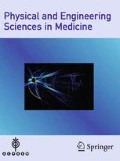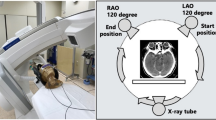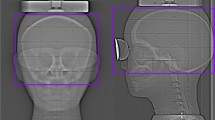Abstract
The eye lens is considered to be among the most radiosensitive human tissues. Brain CT scans may unnecessarily expose it to radiation even if the area of clinical interest is far from the eyes. The aim of this study is to implement a bismuth eye lens shielding system for Head-CT acquisitions in these cases. The study is focused on the assessment of the dosimetric characteristics of the shielding system as well as on its effect on image quality. The shielding system was tested in two set-ups which differ for distance (“contact” and “4 cm” Set up respectively). Scans were performed on a CTDI phantom and an anthropomorphic phantom. A reference set up without shielding system was acquired to establish a baseline. Image quality was assessed by signal (not HU converted), noise and contrast-to-noise ratio (CNR) evaluation. The overall dose reduction was evaluated by measuring the CTDIvol while the eye lens dose reduction was assessed by placing thermoluminescent dosimeters (TLDs) on an anthropomorphic phantom. The image quality analysis exhibits the presence of an artefact that mildly increases the CT number up to 3 cm below the shielding system. Below the artefact, the difference of the Signal and the CNR are negligible between the three different set-ups. Regarding the CTDI, the analysis demonstrates a decrease by almost 12 % (in the “contact” set-up) and 9 % (in the “4 cm” set-up). TLD measurements exhibit an eye lens dose reduction by 28.5 ± 5 and 21.1 ± 5 % respectively at the “contact” and the “4 cm” distance. No relevant artefact was found and image quality was not affected by the shielding system. Significant dose reductions were measured. These features make the shielding set-up useful for clinical implementation in both studied positions.






Similar content being viewed by others
References
Protection ICR (1990) Recommendations of the international commission on radiological protection. ICRP Publication 60: Pergamon, Oxford
Council NR (1990) Health effects exposure to low levels of ionizing radiation. In: BEIRV. National Academy, Washington
Hein E, Rogalla P, Klingebiel R, Hamm B (2002) Low-dose CT of the paranasal sinuses with eye lens protection: effect on image quality and radiation dose. Eur Radiol 12:1693–1696
Wagner LK, Eifel PJ, Geise RA (1994) Potential biological effects following high X-ray dose interventional procedures. J Vasc Interv Radiol 5:71–84
Nishizawa K, Maruyama T, Takayama M, Okada M, Hachiya J, Furuya Y (1991) Determinations of organ doses and effective dose equivalents from computed tomographic examination. Br J Radiol 64:20–28
Ciraj-Bjelac O, Rehani MM, Sim KH, Liew HB, Vano E, Kleiman NJ (2010) Risk for radiation-induced cataract for staff in interventional cardiology: is there reason for concern? Catheter Cardiovasc Interv 76:826–834
Protection ICoR (2011) Statement on tissue reactions. Protection ICoR, Elsevier
Wang J, Duan X, Christner JA, Leng S, Grant KL, McCollough CH (2012) Bismuth shielding, organ-based tube current modulation, and global reduction of tube current for dose reduction to the eye at head CT. Radiology 262:191–198
Hopper KD, Neuman JD, King SH, Kunselman AR (2001) Radioprotection to the eye during CT scanning. Am J Neuroradiol 22:1194–1198
Raissaki M, Perisinakis K, Damilakis J, Gourtsoyiannis N (2010) Eye-lens bismuth shielding in paediatric head CT: artefact evaluation and reduction. Pediatr Radiol 40:1748–1754
McLaughlin DJ, Mooney RB (2004) Dose reduction to radiosensitive tissues in CT. Do commercially available shields meet the users’ needs? Clin Radiol 59:446–450
Heaney DE, Norvill CA (2006) A comparison of reduction in CT dose through the use of gantry angulations or bismuth shields. Aust Phys Eng Sci Med (supported by the Australasian College of Physical Scientists in Medicine and the Australasian Association of Physical Sciences in Medicine) 29:172–178
Nikupaavo U, Kaasalainen T, Reijonen V, Ahonen SM, Kortesniemi M (2015) Lens dose in routine head CT: comparison of different optimization methods with anthropomorphic phantoms. Am J Roentgenol 204:117–123
Reimann AJ, Davison C, Bjarnason T, Thakur Y, Kryzmyk K, Mayo J et al (2012) Organ-based computed tomographic (CT) radiation dose reduction to the lenses: impact on image quality for CT of the head. J Comput Assist Tomogr 36:334–338
Huggett J, Mukonoweshuro W, Loader R (2013) A phantom-based evaluation of three commercially available patient organ shields for computed tomography X-ray examinations in diagnostic radiology. Radiat Prot Dosim 155:161–168
Hopper KD, King SH, Lobell ME, TenHave TR, Weaver JS (1997) The breast: in-plane X-ray protection during diagnostic thoracic CT—shielding with bismuth radioprotective garments. Radiology 205:853–858
Zha Z, Wang S, Shen W, Zhu J, Cai G (1993) Preparation and Characteristics of LiF:mg, Cu, P thermoluminescent material. Radiat Prot Dosimetry 47:111–118
Medicine AAoPi (2012) Use of bismuth shielding for the purpose of dose reduction in CT scanning. American Association of Physicists in Medicine, College Park
Author information
Authors and Affiliations
Corresponding author
Rights and permissions
About this article
Cite this article
Ciarmatori, A., Nocetti, L., Mistretta, G. et al. Reducing absorbed dose to eye lenses in head CT examinations: the effect of bismuth shielding. Australas Phys Eng Sci Med 39, 583–589 (2016). https://doi.org/10.1007/s13246-016-0445-y
Received:
Accepted:
Published:
Issue Date:
DOI: https://doi.org/10.1007/s13246-016-0445-y




